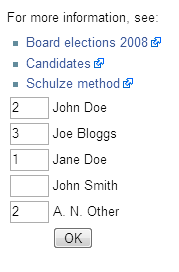Condorcet method facts for kids
A Condorcet method is a way of counting votes in an election. It helps choose a winner who is preferred by more voters than any other candidate, when compared one-on-one. Imagine a contest where every candidate faces off against every other candidate. The person who wins all their head-to-head matches is called the Condorcet winner.
Sometimes, a Condorcet winner might not exist. This can happen if voters' preferences create a cycle, like in the game Rock, Paper, Scissors. For example, Candidate A beats B, B beats C, but C beats A. This tricky situation is known as the Condorcet paradox. However, even when there's no single winner, Condorcet methods can still pick a good candidate from a special group called the Smith set.
These voting methods are named after Marie Jean Antoine Nicolas Caritat, the Marquis de Condorcet. He was an 18th-century French mathematician and philosopher who supported these ideas. But the very first known Condorcet method was actually created much earlier, in 1299, by Ramon Llull.
Condorcet methods usually use a special kind of voting called "preferential voting." This means voters rank candidates from their most favorite (number 1) to their least favorite.
Contents
How Condorcet Voting Works
In Condorcet voting, you rank candidates in order of your preference. You might rank them 1st, 2nd, 3rd, and so on. Sometimes, you can even rank candidates as equal if you like them the same. If you don't rank all candidates, the ones you leave out are usually considered your least favorite.
Here's how the votes are counted:
- Pairwise Comparisons: Imagine every candidate is put into a one-on-one contest with every other candidate. For example, Candidate A versus Candidate B.
- Counting Preferences: For each pair, we count how many voters prefer Candidate A over Candidate B, and how many prefer Candidate B over Candidate A.
- Finding the Winner: If one candidate beats every other candidate in these one-on-one contests, that person is the Condorcet winner!
This method helps find a candidate who is broadly liked by many voters. It's different from other systems that might pick someone who only has a small group of strong supporters.
What if There's No Clear Winner?
Sometimes, due to the Condorcet paradox, there isn't one candidate who beats everyone else. It's like a tie where A beats B, B beats C, and C beats A. In these cases, different Condorcet methods have special rules to pick a winner. These extra rules are called "Condorcet completion methods."
It's important to know that not all voting systems that use ranked choices are Condorcet methods. For example, Instant Runoff Voting and the Borda count are not.
Example: Choosing a Capital City
Let's imagine the state of Tennessee is choosing its new capital. The people in Tennessee live mostly in four big cities:
- Memphis: Has 42% of the voters, but is far from other cities.
- Nashville: Has 26% of the voters, and is near the center.
- Knoxville: Has 17% of the voters.
- Chattanooga: Has 15% of the voters.
People usually want the capital to be close to them. So, their preferences might look like this:
| 42% of voters (close to Memphis) |
26% of voters (close to Nashville) |
15% of voters (close to Chattanooga) |
17% of voters (close to Knoxville) |
|---|---|---|---|
|
|
|
|
To find the Condorcet winner, we compare each city against every other city:
| Pair | Winner |
|---|---|
| Memphis (42%) vs. Nashville (58%) | Nashville |
| Memphis (42%) vs. Chattanooga (58%) | Chattanooga |
| Memphis (42%) vs. Knoxville (58%) | Knoxville |
| Nashville (68%) vs. Chattanooga (32%) | Nashville |
| Nashville (68%) vs. Knoxville (32%) | Nashville |
| Chattanooga (83%) vs. Knoxville (17%) | Chattanooga |
As you can see, Nashville beats every other city in a one-on-one contest. This means Nashville is the Condorcet winner! So, Nashville would be chosen as the capital using any Condorcet method.
Other voting methods, like first-past-the-post or instant-runoff voting, might pick Memphis or Knoxville instead. But Condorcet methods make sure the city most people prefer overall is chosen.
Types of Condorcet Methods
There are different ways to run a Condorcet election.
Two-Method Systems
Some Condorcet methods first try to find a Condorcet winner using pairwise comparisons. If they can't find one (because of a cycle), they switch to a completely different method to pick a winner. For example, the Black method uses the Condorcet winner if there is one. If not, it uses the Borda count, which is another way of counting ranked votes.
Single-Method Systems
Other Condorcet methods use just one procedure that always finds a winner, even if there's a cycle. These methods usually rely on the pairwise comparison results. Some examples include:
- Copeland's method: This method picks the candidate who wins the most one-on-one matches.
- Minimax: This method chooses the candidate whose worst loss in a head-to-head match is still better than anyone else's worst loss.
- Ranked pairs: This method sorts the strongest preferences first and then deals with any cycles by removing the weakest link in the cycle.
- Schulze method: This method also deals with cycles by repeatedly removing the weakest preferences until a winner is found.
Related Terms
Here are a few other terms you might hear:
- Condorcet loser: This is the candidate who loses to every other candidate in a one-on-one match.
- Weak Condorcet winner: A candidate who beats or ties with every other candidate. There can be more than one weak winner.
Condorcet Ranking Methods
Some Condorcet methods don't just pick a single winner. They can create a full ranking of all candidates from first to last place. A Condorcet ranking means the Condorcet winner (if there is one) is ranked first, and the Condorcet loser (if there is one) is ranked last. The same idea applies to all candidates in between.
Methods that can do this include Copeland's method, Kemeny–Young method, Ranked pairs, and the Schulze method.
Condorcet vs. Other Voting Systems
Let's compare Condorcet methods to two other common voting systems:
- Instant Runoff Voting (IRV): In IRV, if your top choice doesn't win, your vote goes to your second choice, and so on. This sounds fair, but sometimes your vote might skip choices if earlier ones are eliminated. Condorcet methods look at all your rankings at once. However, with Condorcet, it's possible that ranking a second choice might accidentally cause your first choice to lose.
- First-past-the-post (FPTP): This is the simplest system. You vote for one candidate, and the one with the most votes wins. People often vote for candidates they think can win, even if they're not their favorite. Condorcet methods let you vote for your true favorite without worrying about "wasting" your vote. They help elect candidates who are widely supported, not just those with the most first-place votes.
Sometimes, both IRV and FPTP might not pick the Condorcet winner. This means a majority of voters would have preferred the Condorcet winner over the person who actually won. Supporters of Condorcet methods believe they are a fairer way to choose leaders because they follow the idea of majority rule.
Is Tactical Voting Possible?
Like all voting methods, Condorcet methods can sometimes be affected by "tactical voting." This is when voters don't vote for their true favorite. Instead, they vote in a way they think will help their preferred candidate win, or prevent a less-preferred candidate from winning.
For example, a voter might strategically rank a candidate higher than they truly prefer to help them. Or, they might rank a candidate lower than they truly prefer to hurt them. This usually only happens in Condorcet methods when there's a Condorcet paradox (a cycle) or when one can be created.
Where Condorcet Voting is Used
Condorcet methods are not commonly used in government elections around the world right now. However, one Condorcet method called Nanson's method was used in city elections in Marquette, Michigan, USA, in the 1920s.
Today, many private organizations use Condorcet methods, especially the Schulze method. These include:
- The Wikimedia Foundation (which runs Wikipedia!) used the Schulze method for its Board of Trustees elections until 2013.
- The Pirate Party of Sweden uses the Schulze method for its internal elections.
- The Debian project (a computer software group) uses the Schulze method for internal votes and to elect its leader.
- The Gentoo Foundation (another software group) uses the Schulze method for its elections.
- The Student Society of the University of British Columbia uses ranked pairs for its executive elections.
Things to Think About
- Counting Votes: If many candidates run (like 10 for governor), counting all the head-to-head matches can be a lot of work. For 10 candidates, there are 45 different pairs to compare! Computers can help speed this up.
- Voter Effort: Voters need to spend time researching and ranking candidates carefully. If voters don't rank enough candidates, or don't rank them accurately, the Condorcet method might not find the best winner.
See also
- Condorcet loser criterion
- Ramon Llull (1232–1315) - He discovered early versions of voting methods, including ideas similar to the Condorcet criterion.
Images for kids
See also
 In Spanish: Método de Condorcet para niños
In Spanish: Método de Condorcet para niños




